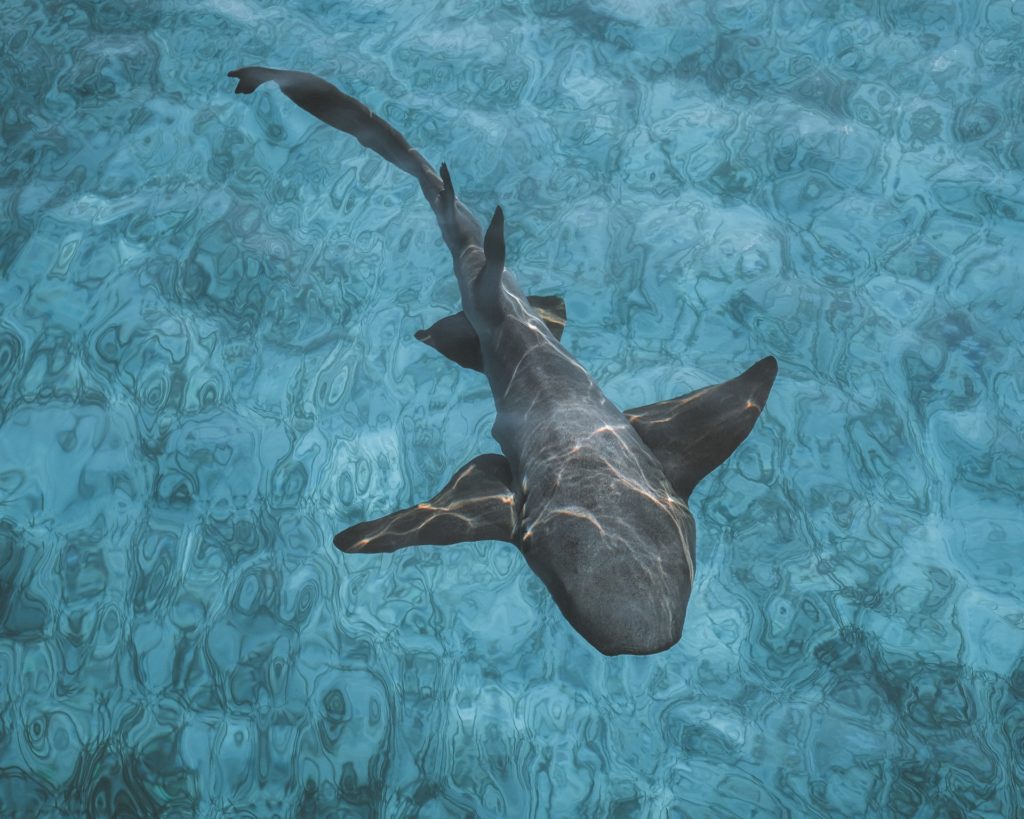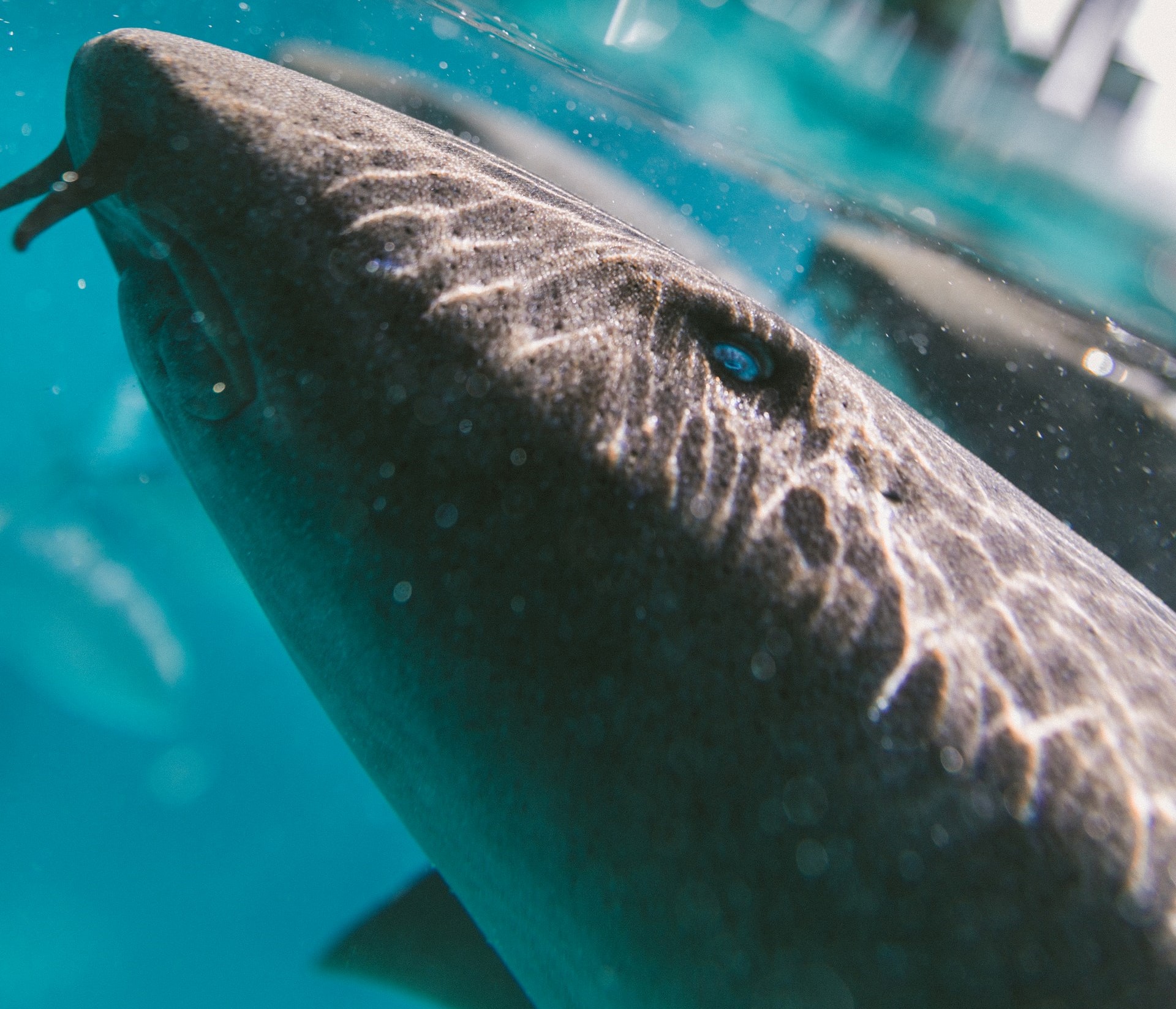Think of some sharks: tiger, hammerhead, bull, . . . nurse? Yes, the nurse shark does in fact exist; it has no formal education and lacks the qualifications to give you medication or a diagnosis. What it wants in formal education, it makes up for in street smarts. This shark, slow and small in comparison to many, can still make it’s own way and survive in the wild and dangerous world of underwater ocean life. Nurse sharks (not to be confused with “grey nurse sharks”) inhabit waters where many tourists enjoy to vacation and dive, especially the Caribbean; near or far, equip yourself here with everything you need to know about the nurse shark.
Physical Traits:
Appearance:

Nurse sharks have rounded dorsal and pectoral fins and a long tail fin. They resemble a catfish, having a wide body and a stylish Fu Manchu (more correctly referred to as barbels) used to detect prey. As far as color, nurse sharks are brown on top, white below. They also have a long tail fin, not quite as long as that of the thresher shark, but still composing up to an impressive ¼ of their total length
How Big Are They?
Up to 10 feet, rumored up to 15. Ricardo Rosa and Andrey Castro researched nurse sharks off the coast of Brazil and published their findings in 2006. The largest shark they encountered was 10 feet (305 cm), and the average was around 6 feet in length; though measured, these could not be weighed because the researchers were diving with the sharks in the wild.
The largest nurse shark caught was 5 feet, 263 pounds. This shark was caught in 2007 off the Florida coast and comes in close to the average size of those observed in Brazil.
Habitat: Where Does The Nurse Shark Live?
- The western Atlantic from Brazil up through the Caribbean and up to Rhode Island towards the northern end of the US.
- The eastern Atlantic from Gabon to Cape Verde. If you think of Africa as Elvis’ head facing left, then it’s a spot in front of him and half way up the hair.
- In the eastern Pacific nurse sharks live from Peru to the North of Mexico.
Nurse sharks spend most of their time near or on the sea floor. The younger and smaller ones live in shallow coral reefs or mangroves while the older and larger ones live in deeper reefs.
Feeding
How Do Nurse Sharks Eat?
They are nocturnal. During the day they spend most of their time in crevices or chosen spots where they lounge under cover in large groups waiting for nightfall. They can sit still because they have the ability to pump water through their gills, meaning they do not need to swim in order to breathe.
When darkness comes, they disperse to begin their hunt, each going their separate ways. They have a small mouth but a large and muscular throat; together, these can create enough suction to vacuum up their prey. Sharks that feed mostly on fish tend to have long, sharp teeth. Nurse sharks, feeding on many hard-shelled creatures, have rows of short small teeth designed to crush their prey.
What Do Nurse Sharks Eat?
Bottom-dwelling fish, shrimp, crustaceans (like lobster), mollusks (like clams), marine snails, tunicates (aka: sea squirts), sea urchins, stingrays, coral, squid, and octopus.
What Are The Nurse Shark’s Predators?
Nothing specifically hunts the nurse shark, but larger sharks will eat them if given the chance, such as tiger sharks, bull sharks, or even lemon sharks.
Relation with humans:
When Was The Nurse Shark Discovered?
The nurse shark was not discovered, but first recorded by the French naturalist Abbé Pierre Joseph Bonnaterre in 1788.
How Did Nurse Sharks Get Their Name?
You may be wondering why we call them “nurse” sharks. Nobody can say conclusively, but we have 2 theories;
Theory 1:
Most likely, the name “nurse” shark comes from an archaic word “nuuse.” Going back to the 15th century, “nusse” actually just means “fish,” but tended to be used in reference to large fish. The ancient name for catsharks was “huss.” These two blended in sound and meaning and evolved into our current rendition of “nurse.”
Nurse sharks themselves do not live in the UK where this name originated, but the cat sharks such as the greater spotted catshark live in the area and very closely resemble our nurse shark. Revealingly, the more common names for this species include the “nursehound” or “bull huss.” Here we see both our contemporary usage of “nurse” and the archaic “huss” both used in reference to a shark similar to the nurse shark.
Now, if you want to go further into it: what we call by the common name “catsharks” are sharks of the family “Scyliorhinidae.” Back in the day, we considered the nurse shark a part of this family, so huss and nusse combining to form their own common name “nurse” made sense. Since then, however, they have received the new family categorization of “Ginglymostomatidae.” Nevertheless, we still call them nurse sharks and in the Caribbean people still call them catsharks.
Theory 2:
Some believe the name comes from the sound they make as they suction up their prey. This seems quite unlikely. It requires English-speaking people to have been swimming underwater with and closely observing the sharks so long ago that we forgot the origin of their name. It makes much more sense that the name evolved from “nusse”. Nevertheless, without conclusive evidence as to the origin of the name, I present both possibilities.
Are Nurse Sharks Dangerous?
They are wild animals so yes, they are dangerous. As far as sharks go, it seems fair to consider nurse sharks one of the good guys. More likely than not, they will swim away rather than confront you; however, if provoked or irritated they are fully capable of biting you and inflicting serious harm. Nurse sharks mostly target small prey items, but they have jaws powerful enough to crush mollusks and even coral. Getting bit by one of these would be no joyride. A nurse shark can and will bite a human, though such events are rare.
Unprovoked Attacks
According to the International Shark Attack file, there have been only 9 unprovoked nurse shark attacks, none of which were fatal.
Provoked Attacks
In contrast, there have been 40-50 provoked attacks, also all non-lethal. These include young sharks, such as the Florida woman who was bitten by a 2 foot shark after other swimmers had grabbed at its tail. In this story, the shark held its grip all the way to the hospital. A large nurse shark in this situation would have been lethal, but, again, we have 0 recorded fatalities from nurse sharks. A nurse shark can kill a human, but never has that we know of.
Like with all sharks (and wild animals), anyone in contact with them should maintain the utmost caution, respect, and even a level of healthy fear regarding these creatures.
Conclusion
Now you know what a nurse shark is and what to expect from it. Though generally not aggressive towards humans, they are best left alone and not agitated. With their highly attuned senses they sweep the ocean floor, searching for prey to vacuum and crush in their powerful jaws. The nurse shark is an interesting creature, somewhat more balanced than other sharks: not the biggest and baddest of sharks, but no small-fry either. They are a specialized animal with a specific role in the ocean.
